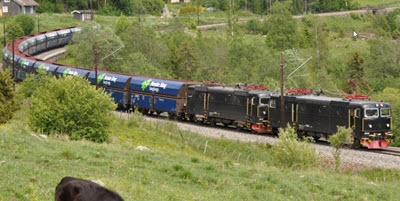Norske Skog Saugbrugs and Bergene Holm Reduce Emissions by Moving From Trucks to Train
The train line will transport timber and wood chips from Bergene Holm in Amundrod near Larvik to Norske Skog Saugbrugs in Halden. The transport to the east will consist of an approximate 50/50 split between wood chips from the sawmill at Amundrod and pulpwood from surrounding forests. In return, Bergene Holm will transport sawn timber from the Halden area to the sawmill at Amundrod. “Norske Skog Saugbrugs works actively to streamline the flow of goods in and out of the factory at the same time as we have set high sustainability goals. With the railway freight of wood chips from Larvik to Halden, we will remove 800 truck loads from the roads. This is a good traffic safety measure, but will also be an excellent environmental improvement as CO2 emissions are reduced,” says Kjell Arve Kure, CEO of Norske Skog Saugbrugs. Thanks to Norske Skog Saugbrug's strategy of moving transport from road to rail, by the end of 2021 the company will annually have a total of 7 500 fewer lorries on Norwegian roads compared with 2015. Following the introduction of all transport measures, Norske Skog Saugbrugs will have reduced CO2 overall emissions for inbound timber and wood chip logistics by just over 25 per cent. Erland Lokken, CEO of Bergene Holm, explained, “Bergene Holm transports 7-800 lorries from the factory in Larvik to Norske Skog Saugbrugs. Using the train both directions between the proposed terminal in Larvik and to Halden will provide environmentally friendly and efficient transport between the mills. “Today's terminal in Skien is not an appropriate or environmentally efficient location for Bergene Holm as it is located in the wrong geographical direction and increased transport distances and costs result in negative environmental accounts. The train will also contribute to securing the raw material supply to the sawmill in Larvik by allowing sawn timber to be returned,” Lokken added. Norske Skog's transition from road to rail has already begun, made possible by previously completed rebuilding to increase the capacity for receiving industrial chips in Halden. The train transport from Amundrod to Norske Skog Saugbrugs started already on 20 November 2020, but requires further measures to reduce transport costs. The most important measure is to move the loading and unloading station from Borgestad to Larvik Harbor. The Port of Larvik has applied to Larvik Municipality for permission to do so. The municipality's processing of the application will be completed with meetings of the chairmanship and the municipal council, on 9 and 16 June, respectively. In addition to lower greenhouse gas emissions, traffic safety will also benefit from Norske Skog's initiative by removing thousands of trucks from the roads. Locally, the measures will also contribute to reduced airborne dust and less emissions of exhaust in places such as Oslo and Halden. About Norske Skog SaugbrugsNorske Skog Saugbrugs has 400 employees, turnover of approximately NOK 2.0 billion, and production capacity of 330 000 tonnes SC magazine paper targeting markets in Europe and North America. Saugbrugs produces 2.0 million normal cubic metres of biogas annually. SOURCE: Norske Skog |

 June 8, 2021 - The transport of timber and wood chips between Larvik and Norske Skog Saugbrugs in Halden has long taken place using trucks. Norske Skog is now using trains on the stretch, which will significantly reduce CO2 emissions from the transport.
June 8, 2021 - The transport of timber and wood chips between Larvik and Norske Skog Saugbrugs in Halden has long taken place using trucks. Norske Skog is now using trains on the stretch, which will significantly reduce CO2 emissions from the transport.